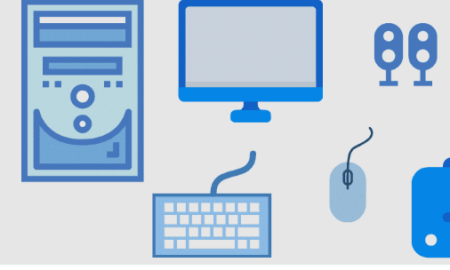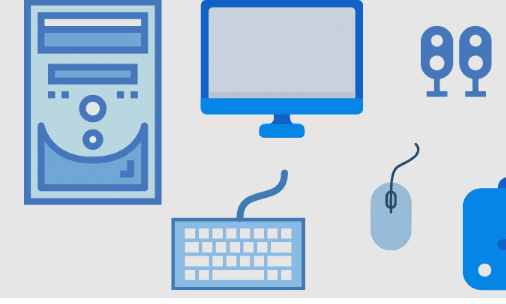In this article, we will explore the various components of a computer and understand their significance in creating a seamless user experience. The computer, in its most visible form, is made up of a series of external parts that facilitate the user’s interaction with the machine. Understanding these parts is not only essential for daily use, but also provides deeper insight into the overall functioning of the system.
Computers Components

Overview of External Parts:
Below, we will explore each of these external computer devices in detail.
Monitor:
The monitor, or screen, is the window to the computer’s graphical interface. Its quality and size directly affect the user’s visual experience.
Keyboard:
This input device allows the user to communicate with the computer through data entry. Modern keyboards may have additional features such as backlighting or programmable keys.
Ratón (Mouse):
The mouse, or mouse, is another input device that facilitates navigation and interaction with the graphical interface. It can be wired or wireless, and its variants range from basic models to advanced ergonomic designs.
Speakers:
Speakers are output devices that allow audio playback. They can be integrated into the monitor or connected externally for a more immersive sound experience
Microphone:
The microphone is an input device that captures ambient sound or the user’s voices. Used for functions such as online calling, voice recording, or voice commands.
Webcam:
The webcam is an integrated or external video camera that allows the capture of images and videos. It is essential for video conferencing, live streaming and multimedia content capture.
WiFi adapter:
The WiFi adapter makes it easy to connect wirelessly to networks, eliminating the need for cables. It is crucial for mobility and internet connection without physical restrictions.
External components of a computer: Types and details
Monitor:
- Screen Types: LCD, LED, OLED.
- Resolution and Refresh Rate: Determinants for image quality.
- Connectivity: HDMI, DisplayPort, VGA ports.
Keyboard:
- Types of Keys: Mechanical, membrane.
- Multimedia and Function Keys: For quick access to various functions.
- Ergonomic Design: Split keyboards, with wrist rest.
Ratón (Mouse):
- Sensors and DPI: Determine the precision of the mouse.
- Programmable Buttons: Customize the mouse’s functionality.
- Design and Ergonomics: Important for comfort during prolonged use.
Speakers:
- Power and Sound Quality: Key aspects for an immersive listening experience.
- Connectivity: Standard audio ports, USB, wireless.
Microphone:
- Microphone Type: Integrated, lapel, headband.
- Noise Cancellation: Feature to reduce unwanted interference.
- Connectivity: Audio or USB ports.
Webcam:
- Video Resolution: Important for the quality of transmissions and recordings.
- Additional Functions: Autofocus, face detection.
- Connectivity: USB, in some cases wireless.
WiFi adapter:
- Connection Standards: 802.11ac, 802.11ax.
- Transfer Speed: Determines the speed of the connection.
- Compatibility: Make sure it is compatible with your network standards.
Connectivity and Ports:
The connection ports are the gateway for peripherals and external devices. USB, HDMI, DisplayPort and Ethernet ports are common and allow connection of a variety of devices, from printers to external cameras.
Computers are composed of multiple components, each serving a specific function. Here’s an overview of the primary components found in most computers:
- Central Processing Unit (CPU): Often referred to as the “brain” of the computer, the CPU performs most of the calculations which enable a computer to function. It processes instructions from both hardware and software.
- Motherboard: The motherboard is the main circuit board of a computer. It connects all the other components together and allows them to communicate with each other. It houses the CPU, memory, and connectors for input and output devices.
- Memory (RAM): Random Access Memory (RAM) is the computer’s short-term memory, which it uses to store data and programs that are in use. It is faster to read from and write to than other kinds of storage, such as a hard disk drive (HDD) or solid-state drive (SSD), but it is also volatile, which means it loses its data when the computer is turned off.
- Storage Devices: These include HDDs, SSDs, and sometimes optical drives like CD, DVD, and Blu-ray drives. Storage devices hold data permanently, unlike RAM. SSDs are faster than HDDs because they don’t have moving parts and access data electronically.
- Power Supply Unit (PSU): The PSU converts electrical power from an outlet into a usable form for the computer. It supplies power to all the components of the computer.
- Graphics Processing Unit (GPU): Also known as the video card, the GPU handles rendering images, video, and animations. It’s particularly important for gaming, video editing, and other graphic-intensive tasks.
- Cooling Systems: These can include fans, heat sinks, and sometimes liquid cooling systems. They dissipate the heat generated by the CPU, GPU, and other components to prevent overheating.
- Input/Output Ports and Expansion Slots: These allow you to connect external devices to the computer. Common ports include USB, HDMI, DisplayPort, and Ethernet. Expansion slots on the motherboard allow for additional components like sound cards, network cards, and additional GPUs.
- Network Interface Controller (NIC): This component, either integrated into the motherboard or added as an expansion card, enables a computer to connect to a network (including the internet) using an Ethernet cable or wirelessly.
- Sound Card: While many motherboards come with integrated sound processing capabilities, dedicated sound cards can provide higher audio quality and more features for audio editing and high-fidelity sound systems.
Each of these components plays a crucial role in the computer’s operation, and advancements in technology continue to improve their efficiency, capacity, and performance.
